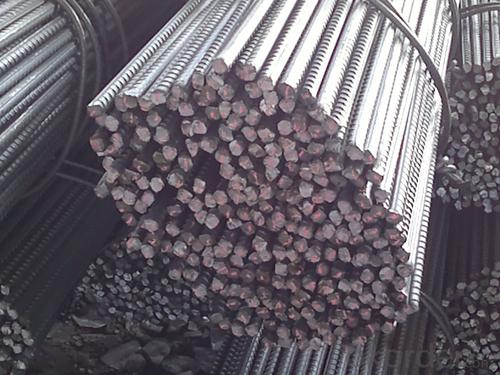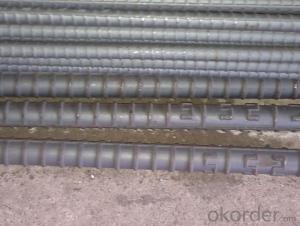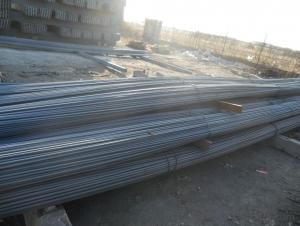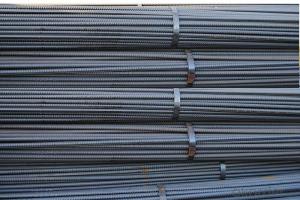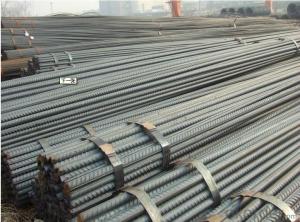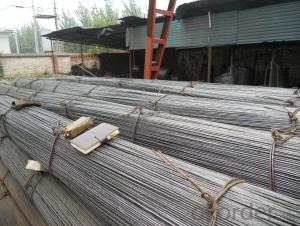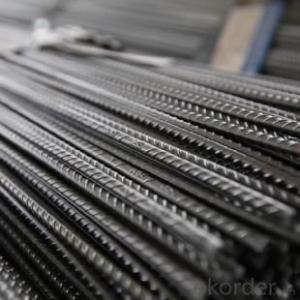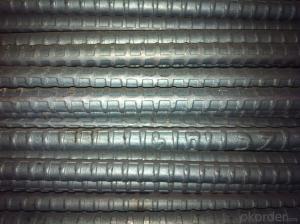Stainless Deformed Steel Rebar Hot Rolled of Diameter:3/8"(10MM)
- Loading Port:
- Tianjin
- Payment Terms:
- TT OR LC
- Min Order Qty:
- 100 m.t.
- Supply Capability:
- 5000 m.t./month
OKorder Service Pledge
OKorder Financial Service
You Might Also Like
Product Description:
OKorder is offering Stainless Deformed Steel Rebar Hot Rolled of Diameter:3/8"(10MM) at great prices with worldwide shipping. Our supplier is a world-class manufacturer of steel, with our products utilized the world over. OKorder annually supplies products to European, North American and Asian markets. We provide quotations within 24 hours of receiving an inquiry and guarantee competitive prices.
Product Applications:
Stainless Deformed Steel Rebar Hot Rolled of Diameter:3/8"(10MM) are ideal for structural applications and are widely used in the construction of buildings and bridges, and the manufacturing, petrochemical, and transportation industries.
Product Advantages:
OKorder's Stainless Deformed Steel Rebar Hot Rolled of Diameter:3/8"(10MM) are durable, strong, and resist corrosion.
Main Product Features:
· Premium quality
· Prompt delivery & seaworthy packing (30 days after receiving deposit)
· Corrosion resistance
· Can be recycled and reused
· Mill test certification
· Professional Service
· Competitive pricing
Specifications of Stainless Deformed Steel Rebar Hot Rolled of Diameter:3/8"(10MM):
Standard | GB UK USA | HRB335 HRB400 HRB500 G460B, B500A, B500B,B500C GR40, GR60 | |
Diameter | 6mm,8mm,10mm,12mm,14mm,16mm,18mm,20mm, 22mm,25mm,28mm,32mm,36mm,40mm,50mm | ||
Length | 6M, 9M,12M or as required | ||
Packing | Export standard packing: wrapped by wire rod in bundles | ||
Each bundle weight | 2-3MT, or as required | ||
Trade terms | FOB, CFR, CIF | ||
Payment terms | TT payment in advance or Irrevocable LC at sight. | ||
Delivery Detail | within 45 days after received advanced payment or LC. | ||
Brand name | DRAGON | ||
Theoretical weight and section area of each diameter as below for your information:
Diameter(mm) | Section area (mm²) | Mass(kg/m) | Weight of 12m (kg) | Pcs/ton |
6 | 28.27 | 0.222 | 2.664 | 375.38 |
8 | 50.27 | 0.395 | 4.74 | 210.97 |
10 | 78.54 | 0.617 | 7.404 | 135.06 |
12 | 113.1 | 0.888 | 10.656 | 93.84 |
14 | 153.9 | 1.21 | 14.52 | 68.87 |
16 | 201.1 | 1.58 | 18.96 | 52.74 |
18 | 254.5 | 2.00 | 24 | 41.67 |
20 | 314.2 | 2.47 | 29.64 | 33.74 |
22 | 380.1 | 2.98 | 35.76 | 27.96 |
25 | 490.9 | 3.85 | 46.2 | 21.65 |
28 | 615.8 | 4.83 | 57.96 | 17.25 |
32 | 804.2 | 6.31 | 75.72 | 13.21 |
36 | 1018 | 7.99 | 98.88 | 10.43 |
40 | 1257 | 9.87 | 118.44 | 8.44 |
50 | 1964 | 15.42 | 185.04 | 5.40 |
Chemical Composition: (Please kindly find our chemistry of our material based on JIS as below for your information)
JISG3112 SD390 | Chemical Composition | ||||
C | Mn | Si | S | P | |
0.22 | 1.38 | 0.4 | 0.014 | 0.022 | |
Physical capability | |||||
Yield Strength(N/cm²) | Tensile Strength(N/cm²) | Elongation (%) | |||
620 | ≥400 | 21 | |||
The production process of Stainless Deformed Steel Rebar Hot Rolled of Diameter:3/8"(10MM)
1-Waling beam furnace
2-Roughing rolling group
3-Intermediate rolling train
4-Finishing rolling group
5-Water-cooling device
6-Walking beam cooler
7-Finishing equipment(including the cold scale shear,short feet collection system,
automatic counting device,bundling machine, collect bench)
Usage and Applications of Stainless Deformed Steel Rebar Hot Rolled of Diameter:3/8"(10MM):
Deformed bar is widely used in buildings, bridges, roads and other engineering construction. Big to highways, railways, bridges, culverts, tunnels, public facilities such as flood control, dam, small to housing construction, beam, column, wall and the foundation of the plate, deformed bar is an integral structure material. With the development of world economy and the vigorous development of infrastructure construction, real estate, the demand for deformed bar will be larger and larger..
Packaging & Delivery of Stainless Deformed Steel Rebar Hot Rolled of Diameter:3/8"(10MM):
Packaging Detail: products are packed in bundle and then shipped by container or bulk vessel, deformed bar is usually naked strapping delivery, when storing, please pay attention to moisture proof. The performance of rust will produce adverse effect.
Price: Keep lower operating costs so as to offer competitive price for our clients
FAQ:
Q1: Why buy Materials & Equipment from OKorder.com?
A1: All products offered byOKorder.com are carefully selected from China's most reliable manufacturing enterprises. Through its ISO certifications, OKorder.com adheres to the highest standards and a commitment to supply chain safety and customer satisfaction.
Q2: How do we guarantee the quality of our products?
A2: We have established an advanced quality management system which conducts strict quality tests at every step, from raw materials to the final product. At the same time, we provide extensive follow-up service assurances as required.
Q3: How soon can we receive the product after purchase?
A3: Within three days of placing an order, we will begin production. The specific shipping date is dependent upon international and government factors, but is typically 7 to 10 workdays.
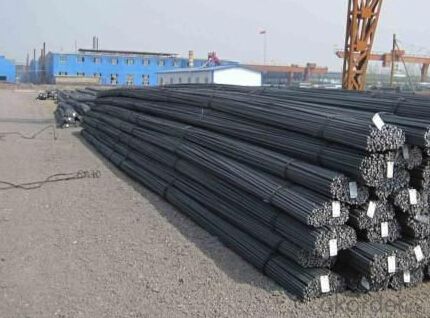
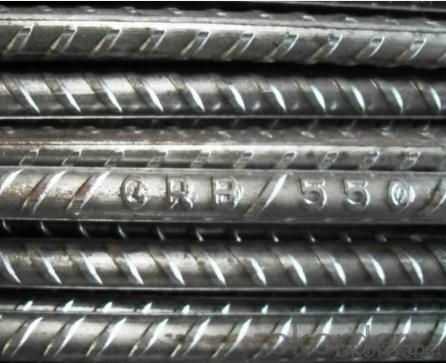
- Q: Can steel rebars be used in seismic-resistant construction?
- Yes, steel rebars can be used in seismic-resistant construction. Steel rebars provide strength and flexibility to reinforced concrete structures, making them more capable of withstanding seismic forces. They help distribute the energy generated during an earthquake, reducing the chances of structural failure and ensuring the safety of the building and its occupants.
- Q: Are there any limitations or restrictions on using steel rebars in construction?
- Yes, there are certain limitations and restrictions on using steel rebars in construction. Here are some of them: 1. Corrosion: Steel rebars are prone to corrosion when exposed to moisture and certain chemical environments. This can weaken the rebars over time and compromise the structural integrity of the construction. To mitigate this limitation, protective coatings or stainless steel rebars can be used. 2. Fire Resistance: Steel rebars can lose their strength and become malleable when exposed to high temperatures during a fire. This can lead to structural failure. Fireproofing measures such as fire-resistant coatings or using concrete encasement can help enhance the fire resistance of steel rebars. 3. Weight: Steel rebars can be quite heavy, especially for large-scale construction projects. This can pose challenges during transportation, handling, and installation. It may require additional labor or equipment to handle the weight, which can increase project costs. 4. Thermal Expansion: Steel has a relatively high coefficient of thermal expansion, meaning it expands and contracts significantly with temperature changes. This can lead to thermal stresses and potential cracking in the concrete surrounding the rebars. Proper design techniques and the use of expansion joints can help accommodate thermal expansion and mitigate this limitation. 5. Electromagnetic Interference: Steel rebars can interfere with electromagnetic signals, such as those used in communication systems or sensitive electronic equipment. This limitation needs to be considered when constructing buildings with specific requirements, such as hospitals or laboratories. 6. Cost: The cost of steel rebars can fluctuate depending on market conditions, availability, and quality. This can impact the overall budget of construction projects, especially when large quantities of rebars are required. It is important to note that while steel rebars have limitations, they have been widely used in construction due to their strength, durability, and availability. Proper design, construction techniques, and maintenance can help overcome these limitations and ensure the safe and efficient use of steel rebars in buildings and infrastructure.
- Q: What are the different methods of connecting steel rebars?
- There are several methods of connecting steel rebars, including lap splicing, mechanical splicing, and welded splicing. Lap splicing involves overlapping the rebars and tying them together with wire or using mechanical anchoring devices. Mechanical splicing utilizes couplers or threaded sleeves to join the rebars together. Welded splicing involves welding the rebars together using electric arc or gas welding techniques. Each method has its own advantages and is chosen based on the specific requirements of the construction project.
- Q: What are the advantages of using fiber-reinforced polymer (FRP) rebars over steel rebars?
- Using fiber-reinforced polymer (FRP) rebars instead of traditional steel rebars in construction projects offers several advantages: 1. Superior corrosion resistance: FRP rebars do not corrode like steel rebars, which are prone to rust and deterioration when exposed to moisture and chemicals. This property significantly enhances the durability and lifespan of structures, especially in harsh environmental conditions. 2. Lightweight nature: FRP rebars are significantly lighter than steel rebars, making them easier to handle, transport, and install. This lightweight characteristic also reduces the overall dead load of a structure, allowing for more efficient design and construction. 3. Impressive strength-to-weight ratio: Despite being lightweight, FRP rebars possess a high strength-to-weight ratio, enabling them to bear heavy loads while maintaining their structural integrity. This quality makes FRP rebars ideal for applications where weight reduction is desired without compromising strength, such as in bridge decks and seismic reinforcement. 4. Non-magnetic and non-conductive properties: Unlike steel rebars, FRP rebars are non-magnetic and non-conductive. This feature proves advantageous in structures that require non-magnetic properties, like MRI rooms in hospitals, or situations where electrical conductivity needs to be minimized, such as in power plants or near electrical equipment. 5. Flexibility in design: FRP rebars can be manufactured in various shapes and sizes, offering design flexibility and customization options to meet specific project requirements. They can be easily cut and shaped on-site, allowing for seamless integration into complex geometries and curved structures. 6. Thermal compatibility: FRP rebars possess a low coefficient of thermal expansion, meaning they expand and contract at a similar rate to the surrounding concrete. This thermal compatibility reduces the risk of cracking and ensures better long-term performance of the structure, especially in areas with extreme temperature variations. 7. Outstanding durability: FRP rebars exhibit excellent long-term durability, even in aggressive environments. They are resistant to alkalis, chemicals, and UV radiation, ensuring their performance and structural integrity over an extended period. 8. Environmentally friendly: FRP rebars are considered more environmentally friendly than steel rebars due to their minimal carbon footprint. They require less energy to produce and generate fewer greenhouse gas emissions during manufacturing. Additionally, FRP rebars are non-toxic and do not pose a threat to the environment during their lifespan or at the end of their service life. Overall, the benefits of using FRP rebars make them a viable alternative to steel rebars in various construction applications. They offer improved durability, lightweight design, corrosion resistance, and enhanced structural performance.
- Q: Can steel rebars be cut on-site during construction?
- Steel rebars can indeed be cut on-site during construction. They are frequently utilized in reinforced concrete structures to enhance their durability and stability. To meet the design specifications, it may be necessary to trim the rebars to certain lengths or shapes. This task can be accomplished with a range of tools including rebar cutters, angle grinders, or oxy-fuel cutting torches. Nevertheless, it is crucial to adhere to safety protocols and employ suitable protective equipment while cutting rebars on-site in order to avert any mishaps or harm.
- Q: What are the safety precautions to be followed while working with steel rebars?
- When working with steel rebars, it is crucial to follow certain safety precautions to prevent accidents and injuries. Here are some precautions to consider: 1. Personal Protective Equipment (PPE): Always wear appropriate PPE, including safety glasses, gloves, hard hats, and steel-toed boots. These items will protect you from potential hazards such as falling objects, sharp edges, and flying debris. 2. Training and Knowledge: Before working with steel rebars, ensure that you have received proper training and understand the safety protocols associated with this task. Familiarize yourself with the equipment being used and understand the potential risks involved. 3. Proper Lifting Techniques: Steel rebars can be heavy and awkward to handle. Always use proper lifting techniques, such as bending your knees and using your legs to lift rather than your back. Never attempt to lift a rebar that is too heavy for you; ask for assistance if needed. 4. Secure Storage: Store steel rebars in a designated area that is clear of any potential obstructions. Stack them in a stable manner to prevent them from toppling over and causing injuries. 5. Safe Handling: When moving steel rebars, be cautious of their sharp edges and potential for injury. Use appropriate lifting equipment, such as cranes or forklifts, if necessary. Avoid dragging or sliding rebars, as this can cause strains or sprains. 6. Fall Protection: If working at heights or near open edges, ensure that proper fall protection measures are in place. This may include using guardrails, safety harnesses, or safety nets to prevent falls. 7. Fire Safety: Steel rebars can become extremely hot when exposed to heat or flame. Ensure that there are proper fire prevention measures in place, such as fire extinguishers, and be cautious when working near flammable materials. 8. Communication: Maintain clear communication with co-workers and supervisors to ensure everyone is aware of their surroundings and potential hazards. Use hand signals or radios when working in noisy environments. 9. Regular Inspections: Regularly inspect steel rebars for any defects, such as cracks or sharp edges, that could pose a safety risk. Remove any damaged or faulty rebars from use immediately. 10. First Aid and Emergency Procedures: Be familiar with first aid procedures and emergency protocols in case of accidents or injuries. Have a well-stocked first aid kit readily available on-site and know the location of the nearest medical facility. By following these safety precautions, you can minimize the risk of accidents and injuries while working with steel rebars. Always prioritize your safety and the safety of those around you.
- Q: Can steel rebars be used in historical building preservation?
- Yes, steel rebars can be used in historical building preservation. They are commonly used to strengthen and reinforce existing structures, ensuring their structural integrity. Steel rebars provide additional support and stability to historical buildings without compromising their original architectural integrity.
- Q: What are the guidelines for preventing steel rebars from rusting during construction delays?
- In order to prevent steel rebars from rusting during construction delays, it is crucial to adhere to the following guidelines: 1. Adequate Storage: Rebars should be stored in a covered and dry area, away from moisture and direct sunlight. It is important to ensure that the storage area is well-ventilated to avoid condensation. 2. Use of VCI (Volatile Corrosion Inhibitor) Products: Incorporate VCI products such as VCI paper, films, or emitters. These products release chemicals that inhibit corrosion and create a protective layer on the rebars, preventing rust formation. 3. Proper Packaging: If rebars need to be transported or stored for a long period, it is essential to package them correctly. Wrap the rebars tightly with VCI paper or plastic sheets and secure the packaging with tape to prevent moisture from seeping in. 4. Dehumidification: Install dehumidifiers in areas where the rebars are stored to reduce humidity levels. This will help maintain a dry environment and prevent condensation on the rebars. 5. Regular Inspection: Conduct periodic inspections to check for any signs of rust formation on the rebars. If rust is detected, it should be promptly cleaned and treated with anti-corrosion coatings to prevent further damage. 6. Application of Protective Coatings: Apply anti-corrosion coatings on the rebars to provide an additional layer of protection. The choice of coating, whether epoxy-based or zinc-based, should depend on the environmental conditions and project requirements. 7. Eliminate Standing Water: Make sure there is no standing water in the vicinity of the rebars, as it can expedite the rusting process. Implement proper drainage systems to prevent water accumulation. 8. Monitoring: Regularly monitor the environmental conditions, including temperature and humidity levels, to identify any potential risks of rust formation. Adjust the storage conditions accordingly, if necessary. By adhering to these guidelines, construction delays can be effectively managed, and the steel rebars can be safeguarded from rust formation, ensuring the structural integrity of the project.
- Q: Can steel rebars be used in coastal areas?
- Yes, steel rebars can be used in coastal areas. However, it is important to note that the rebars need to be properly coated or protected against corrosion due to the higher levels of salt and moisture in coastal environments.
- Q: What are the common quality tests performed on steel rebars?
- The common quality tests performed on steel rebars include visual inspection, dimensional measurement, tensile strength testing, bending test, weldability test, and corrosion resistance test.
Send your message to us
Stainless Deformed Steel Rebar Hot Rolled of Diameter:3/8"(10MM)
- Loading Port:
- Tianjin
- Payment Terms:
- TT OR LC
- Min Order Qty:
- 100 m.t.
- Supply Capability:
- 5000 m.t./month
OKorder Service Pledge
OKorder Financial Service
Similar products
Hot products
Hot Searches
Related keywords





